The Potential of Using Tree-Ring Chronology from the Southern Coast of Korea to Reconstruct the Climate of Subtropical Western North Pacific: A Pilot Study
Abstract
1. Introduction
2. Materials and Methods
2.1. Study Area and Climate
2.2. Tree-Ring Sampling and Development of TRW Chronologies
2.3. Climatic Data
3. Results and Discussions
3.1. Characteristics of TRW Chronologies from Mt. Mudeung and Mt. Wolchul
3.2. Climatic Responses of TRW Chronologies from Mt. Mudeung and Mt. Wolchul
3.3. Oceanic Signals of the Tree Growth over the Western North Pacific
4. Summary and Conclusions
Supplementary Materials
Author Contributions
Funding
Acknowledgments
Conflicts of Interest
References
- Neukom, R.; Steiger, N.; Gómez-Navarro, J.J.; Wang, J.; Werner, J.P. No Evidence for Globally Coherent Warm and Cold Periods over the Preindustrial Common Era. Nature 2019, 571, 550–554. [Google Scholar] [CrossRef]
- PAGES 2k Consortium; Neukom, R.; Barboza, L.A.; Erb, M.P.; Shi, F.; Emile-Geay, J.; Evans, M.N.; Franke, J.; Kaufman, D.S.; Lücke, L.; et al. Consistent Multi-Decadal Variability in Global Temperature Reconstructions and Simulations over the Common Era. Nat. Geosci. 2019, 12, 643–649. [Google Scholar] [CrossRef]
- Zhang, P.; Ionita, M.; Lohmann, G.; Chen, D.; Linderholm, H.W. Can Tree-Ring Density Data Reflect Summer Temperature Extremes and Associated Circulation Patterns over Fennoscandia? Clim. Dyn. 2017, 49, 2721–2736. [Google Scholar] [CrossRef]
- Wilson, R.; Miles, D.; Loader, N.J.; Melvin, T.; Cunningham, L.; Cooper, R.; Briffa, K. A Millennial Long March–July Precipitation Reconstruction for Southern-Central England. Clim. Dyn. 2013, 40, 997–1017. [Google Scholar] [CrossRef]
- Ahmed, M.; Anchukaitis, K.J.; Asrat, A.; Borgaonkar, H.P.; Braida, M.; Buckley, B.M.; Büntgen, U.; Chase, B.M.; Christie, D.A.; Cook, E.R. Continental-Scale Temperature Variability During the past Two Millennia. Nat. Geosci. 2013, 6, 339–346. [Google Scholar]
- Steinman, B.A.; Abbott, M.B.; Mann, M.E.; Stansell, N.D.; Finney, B.P. 1500 Year Quantitative Reconstruction of Winter Precipitation in the Pacific Northwest. Proc. Natl. Acad. Sci. USA 2012, 109, 11619–11623. [Google Scholar] [CrossRef] [PubMed]
- Cook, E.R.; Anchukaitis, K.J.; Buckley, B.M.; D’Arrigo, R.D.; Jacoby, G.C.; Wright, W.E. Asian Monsoon Failure and Megadrought During the Last Millennium. Science 2010, 328, 486–489. [Google Scholar] [CrossRef] [PubMed]
- Gray, S.T.; Graumlich, L.J.; Betancourt, J.L.; Pederson, G.T. A Tree-Ring Based Reconstruction of the Atlantic Multidecadal Oscillation Since 1567 A.D. Geophys. Res. Lett. 2004, 31. [Google Scholar] [CrossRef]
- Cook, E.R.; D’Arrigo, R.D.; Mann, M.E. A Well-Verified, Multiproxy Reconstruction of the Winter North Atlantic Oscillation Index Since A.D. 1400. J. Clim. 2002, 15, 1754–1764. [Google Scholar] [CrossRef]
- St. George, S.S. An Overview of Tree-Ring Width Records Across the Northern Hemisphere. Quat. Sci. Rev. 2014, 95, 132–150. [Google Scholar] [CrossRef]
- Lee, M.-H.; Ho, C.-H.; Kim, J.; Song, C.-K. Assessment of the Changes in Extreme Vulnerability over East Asia Due to Global Warming. Clim. Chang. 2012, 113, 301–321. [Google Scholar] [CrossRef]
- Wang, Y.L.; Wu, C.R.; Chao, S.Y. Warming and Weakening Trends of the Kuroshio During 1993–2013. Geophys. Res. Lett. 2016, 43, 9200–9207. [Google Scholar] [CrossRef]
- Wu, L.; Cai, W.; Zhang, L.; Nakamura, H.; Timmermann, A.; Joyce, T.; McPhaden, M.J.; Alexander, M.; Qiu, B.; Visbeck, M.; et al. Enhanced Warming over the Global Subtropical Western Boundary Currents. Nat. Clim. Chang. 2012, 2, 161–166. [Google Scholar] [CrossRef]
- Park, Y.-H.; Yoon, J.-H.; Youn, Y.-H.; Vivier, F. Recent Warming in the Western North Pacific in Relation to Rapid Changes in the Atmospheric Circulation of the Siberian High and Aleutian Low Systems. J. Clim. 2012, 25, 3476–3493. [Google Scholar] [CrossRef]
- Kamae, Y.; Mei, W.; Xie, S.-P. Ocean Warming Pattern Effects on Future Changes in East Asian Atmospheric Rivers. Environ. Res. Lett. 2019, 14. [Google Scholar] [CrossRef]
- Mitchell, D.; AchutaRao, K.; Allen, M.; Bethke, I.; Beyerle, U.; Ciavarella, A.; Forster, P.M.; Fuglestvedt, J.; Gillett, N.; Haustein, K.; et al. Half a Degree Additional Warming, Prognosis and Projected Impacts (HAPPI): Background and Experimental Design. Geosci. Model Dev. 2017, 10, 571–583. [Google Scholar] [CrossRef]
- Yang, H.; Lohmann, G.; Wei, W.; Dima, M.; Ionita, M.; Liu, J. Intensification and Poleward Shift of Subtropical Western Boundary Currents in a Warming Climate. J. Geophys. Res. Ocean. 2016, 121, 4928–4945. [Google Scholar] [CrossRef]
- Kottek, M.; Grieser, J.; Beck, C.; Rudolf, B.; Rubel, F. World Map of the Köppen-Geiger Climate Classification Updated. Meteorol. Z. 2006, 15, 259–263. [Google Scholar] [CrossRef]
- Chen, F.; Opała-Owczarek, M.; Owczarek, P.; Chen, Y. Summer Monsoon Season Streamflow Variations in the Middle Yellow River Since 1570 CE Inferred from Tree Rings of Pinus Tabulaeformis. Atmosphere 2020, 11, 717. [Google Scholar] [CrossRef]
- Sun, C.; Liu, Y.; Song, H.; Mei, R.; Payomrat, P.; Wang, L.; Liu, R. Tree-Ring-Based Precipitation Reconstruction in the Source Region of Weihe River, Northwest China Since AD 1810. Int. J. Climatol. 2018, 38, 3421–3431. [Google Scholar] [CrossRef]
- Shi, J.; Lu, H.; Li, J.; Shi, S.; Wu, S.; Hou, X.; Li, L. Tree-Ring Based February–April Precipitation Reconstruction for the Lower Reaches of the Yangtze River, Southeastern China. Glob. Planet. Chang. 2015, 131, 82–88. [Google Scholar] [CrossRef]
- Cai, Q.; Liu, Y.; Lei, Y.; Bao, G.; Sun, B. Reconstruction of the March–August PDSI Since 1703 AD Based on Tree Rings of Chinese Pine (Pinus Tabulaeformis Carr.) in the Lingkong Mountain, Southeast Chinese Loess Plateau. Clim. Past 2014, 10, 509–521. [Google Scholar] [CrossRef]
- Yi, L.; Yu, H.; Ge, J.; Lai, Z.; Xu, X.; Qin, L.; Peng, S. Reconstructions of Annual Summer Precipitation and Temperature in North-Central China Since 1470 AD Based on Drought/Flood Index and Tree-Ring Records. Clim. Chang. 2012, 110, 469–498. [Google Scholar] [CrossRef]
- Fang, K.; Gou, X.; Chen, F.; Liu, C.; Davi, N.; Li, J.; Zhao, Z.; Li, Y. Tree-Ring Based Reconstruction of Drought Variability (1615–2009) in the Kongtong Mountain Area, Northern China. Glob. Planet. Chang. 2012, 80–81, 190–197. [Google Scholar] [CrossRef]
- Duan, J.; Zhang, Q.-B.; Lv, L.; Zhang, C. Regional-Scale Winter-Spring Temperature Variability and Chilling Damage Dynamics over the past Two Centuries in Southeastern China. Clim. Dyn. 2012, 39, 919–928. [Google Scholar] [CrossRef]
- Yonenobu, H.; Eckstein, D. Reconstruction of early spring temperature for central Japan from the tree-ring widths of Hinoki cypress and its verification by other proxy records. Geophys. Res. Lett. 2006, 33. [Google Scholar] [CrossRef]
- Park, W.-K.; Yadav, R.R. Reconstruction of May Precipitation (AD 1731–1995) in West-Central Korea from Tree Rings of Korean Red Pine. Asia Pac. J. Atmos. Sci. 1998, 34, 459–465. [Google Scholar]
- Zhang, P.; Jeong, J.-H.; Linderholm, H.W.; Jeong, J.-Y.; Salo, R.; Kim, B.-M.; Kim, M.-S. The Potential of Using Tree-Ring Data from Jeju Island to Reconstruct Climate in Subtropical Korea and the Western North Pacific. Asia Pac. J. Atmos. Sci. 2019, 55, 293–301. [Google Scholar] [CrossRef]
- Hong, H.-H.; Jang, J.-W.; Sun, E.-M.; Kim, B.-A.; Kim, S.-J.; -Seo, S.-R.; Im, H.-T. Floristic Study of Mt. Mudeung. Korean J. Environ. Biol. 2013, 31, 121–153. [Google Scholar] [CrossRef]
- Oh, K.; Jeong, S.; Kim, Y. Actual Vegetation and Plant Community Structure in the Wolchulsan National Park. Korean J. Environ. Ecol. 1999, 17, 26–34. [Google Scholar]
- Lim, J.-H.; Park, G.-E.; Moon, N.-H.; Moon, G.-H.; Shin, M.-Y. Analysing the Relationship Between Tree-Ring Growth of Pinus densiflora and Climatic Factors Based on National Forest Inventory Data. J. Korean Soc. For. Sci. 2017, 106, 249–257. [Google Scholar] [CrossRef]
- Choi, H.-A.; Lee, W.-K.; Byun, J.-G.; Kwak, H.-B.; Kim, S.-R.; Byun, W.-H. Spatial Distribution and Radial Growth Response of Pinus densiflora to Climatic and Topographic Factors in Central Urban Forest of Seoul, Korea. J. For. Plan. 2011, 16, 163–169. [Google Scholar] [CrossRef]
- Park, W.-K.; Yadav, R.R. A Dendroclimatic Analysis of Pinus densiflora from Mt. Chiri in Southern Korea. Ann. For. Sci. 1998, 55, 451–459. [Google Scholar] [CrossRef]
- Grissino-Mayer, H.D. Evaluating Crossdating Accuracy: A Manual and Tutorial for the Computer Program COFECHA. Tree-Ring Res. 2001, 57, 205–221. [Google Scholar]
- Holmes, R.L. Computer-Assisted Quality Control in Tree-Ring Dating and Measurement. Tree-Ring Bull. 1983, 43, 69–78. [Google Scholar]
- Cook, E.R. A Time Series Analysis Approach to Tree Ring Standardization. Ph.D. Thesis, University of Arizona, Tucson, AZ, USA, 1985. [Google Scholar]
- Fritts, H.C. Tree Rings and Climate; Academic Press: London, UK, 1976. [Google Scholar]
- Wigley, T.M.L.; Briffa, K.R.; Jones, P.D. On the Average Value of Correlated Time Series, with Applications in Dendroclimatology and Hydrometeorology. J. Clim. Appl. Meteor. 1984, 23, 201–213. [Google Scholar] [CrossRef]
- KMA (Korea Meteorological Administration) ASOS (Automatic Synoptic Observation System) station data. Available online: https://data.kma.go.kr (accessed on 29 March 2019).
- Morice, C.P.; Kennedy, J.J.; Rayner, N.A.; Jones, P.D. Quantifying Uncertainties in Global and Regional Temperature Change Using an Ensemble of Observational Estimates: The HadCRUT4 Data Set. J. Geophys. Res. 2012, 117. [Google Scholar] [CrossRef]
- Xie, P.; Arkin, P.A. Global Precipitation: A 17-Year Monthly Analysis Based on Gauge Observations, Satellite Estimates, and Numerical Model Outputs. Bull. Am. Meteor. Soc. 1997, 78, 2539–2558. [Google Scholar] [CrossRef]
- Rayner, N.A.; Parker, D.E.; Horton, E.; Folland, C.K.; Alexander, L.V.; Rowell, D.; Kent, E.; Kaplan, A. Global Analyses of Sea Surface Temperature, Sea Ice, and Night Marine Air Temperature Since the Late Nineteenth Century. J. Geophys. Res. 2003, 108. [Google Scholar] [CrossRef]
- Kobayashi, S.; Ota, Y.; Harada, Y.; Ebita, A.; Moriya, M.; Onoda, H.; Onogi, K.; Kamahori, H.; Kobayashi, C.; Endo, H.; et al. The JRA-55 Reanalysis: General Specifications and Basic Characteristics. J. Meteorol. Soc. Jpn. 2015, 93, 5–48. [Google Scholar] [CrossRef]
- NCAR. The NCAR Command Language; Software, Version 6.6.2; UCAR/NCAR/CISL/TDD: Boulder, CO, USA, 2019. [Google Scholar] [CrossRef]
- Linderholm, H.W. Climatic Influence on Scots Pine Growth on Dry and Wet Soils in the Central Scandinavian Mountains, Interpreted from Tree-Ring Width. Silva Fenn. 2001, 35, 415–424. [Google Scholar] [CrossRef]
- Hirota, N.; Takahashi, M. A Tripolar Pattern as an Internal Mode of the East Asian Summer Monsoon. Clim. Dyn. 2012, 39, 2219–2238. [Google Scholar] [CrossRef]
- Zhu, C.; Wang, B.; Qian, W.; Zhang, B. Recent Weakening of Northern East Asian Summer Monsoon: A Possible Response to Global Warming. Geophys. Res. Lett. 2012, 39. [Google Scholar] [CrossRef]
- Yu, R.; Wang, B.; Zhou, T. Tropospheric Cooling and Summer Monsoon Weakening Trend over East Asia. Geophys. Res. Lett. 2004, 31. [Google Scholar] [CrossRef]
- Ham, Y.-G.; Na, H.-Y.; Oh, S.-H. Role of Sea Surface Temperature over the Kuroshio Extension Region on Heavy Rainfall Events over the Korean Peninsula. Asia Pac. J. Atmos. Sci. 2019, 55, 19–29. [Google Scholar] [CrossRef]
- Wang, B.; Xiang, B.; Lee, J.Y. Subtropical High Predictability Establishes a Promising Way for Monsoon and Tropical Storm Predictions. Proc. Natl. Acad. Sci. USA 2013, 110, 2718–2722. [Google Scholar] [CrossRef]
- Lee, S.-S.; Seo, Y.-W.; Ha, K.-J.; Jhun, J.-G. Impact of the Western North Pacific Subtropical High on the East Asian Monsoon Precipitation and the Indian Ocean Precipitation in the Boreal Summertime. Asia Pac. J. Atmos. Sci. 2013, 49, 171–182. [Google Scholar] [CrossRef]
- Lee, E.J.; Yeh, S.W.; Jhun, J.G.; Moon, B.K. Seasonal Change in Anomalous WNPSH Associated with the Strong East Asian Summer Monsoon. Geophys. Res. Lett. 2006, 33. [Google Scholar] [CrossRef]
- Wang, B.; Wu, R.; Fu, X. Pacific–East Asian Teleconnection: How Does ENSO Affect East Asian Climate? J. Clim. 2000, 13, 1517–1536. [Google Scholar] [CrossRef]
- North, G.R.; Bell, T.L.; Cahalan, R.F.; Moeng, F.J. Sampling Errors in the Estimation of Empirical Orthogonal Functions. Mon. Wea. Rev. 1982, 110, 699–706. [Google Scholar] [CrossRef]
- Larkin, N.K.; Harrison, D.E. ENSO Warm (El Niño) and Cold (La Niña) Event Life Cycles: Ocean Surface Anomaly Patterns, Their Symmetries, Asymmetries, and Implications. J. Clim. 2002, 15, 1118–1140. [Google Scholar] [CrossRef]

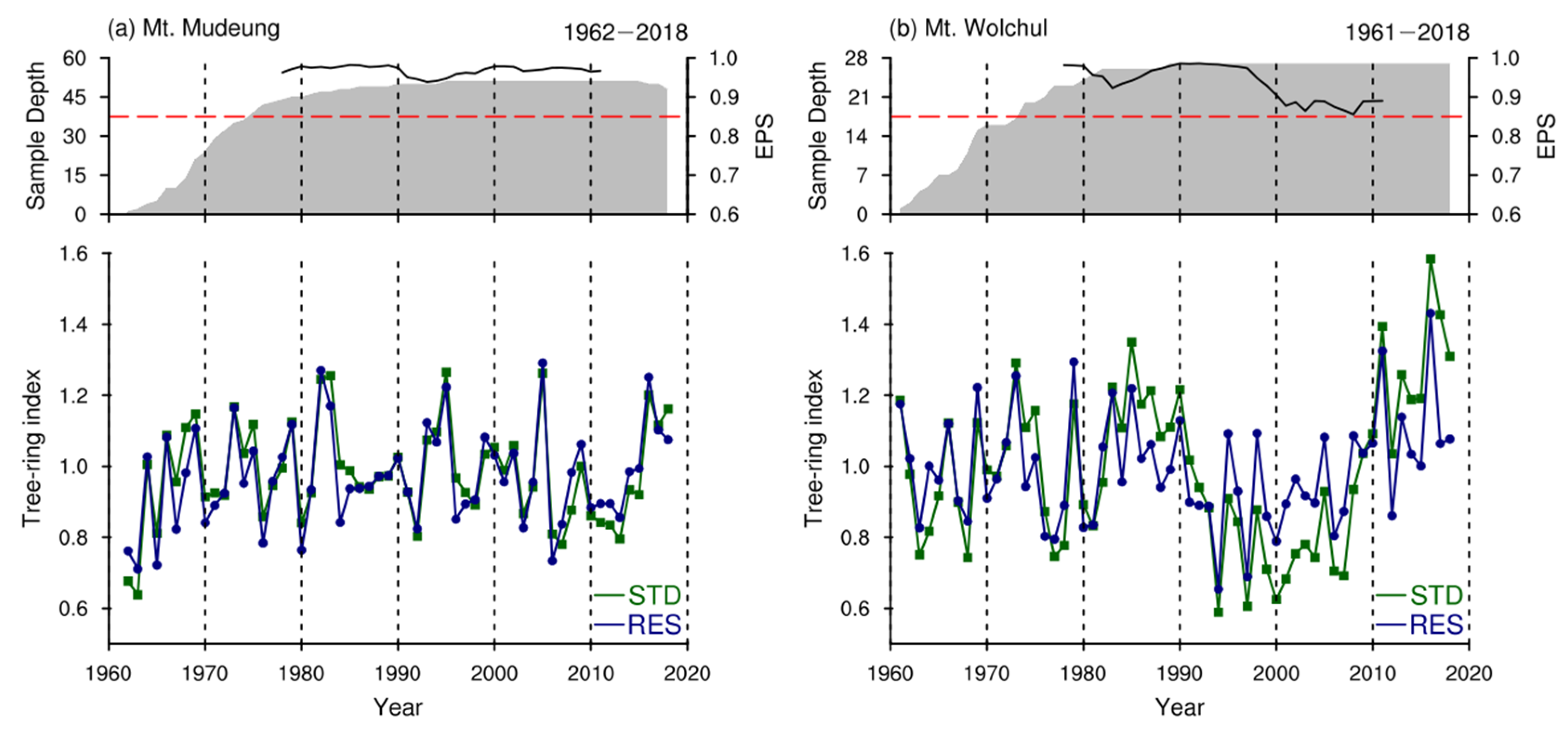
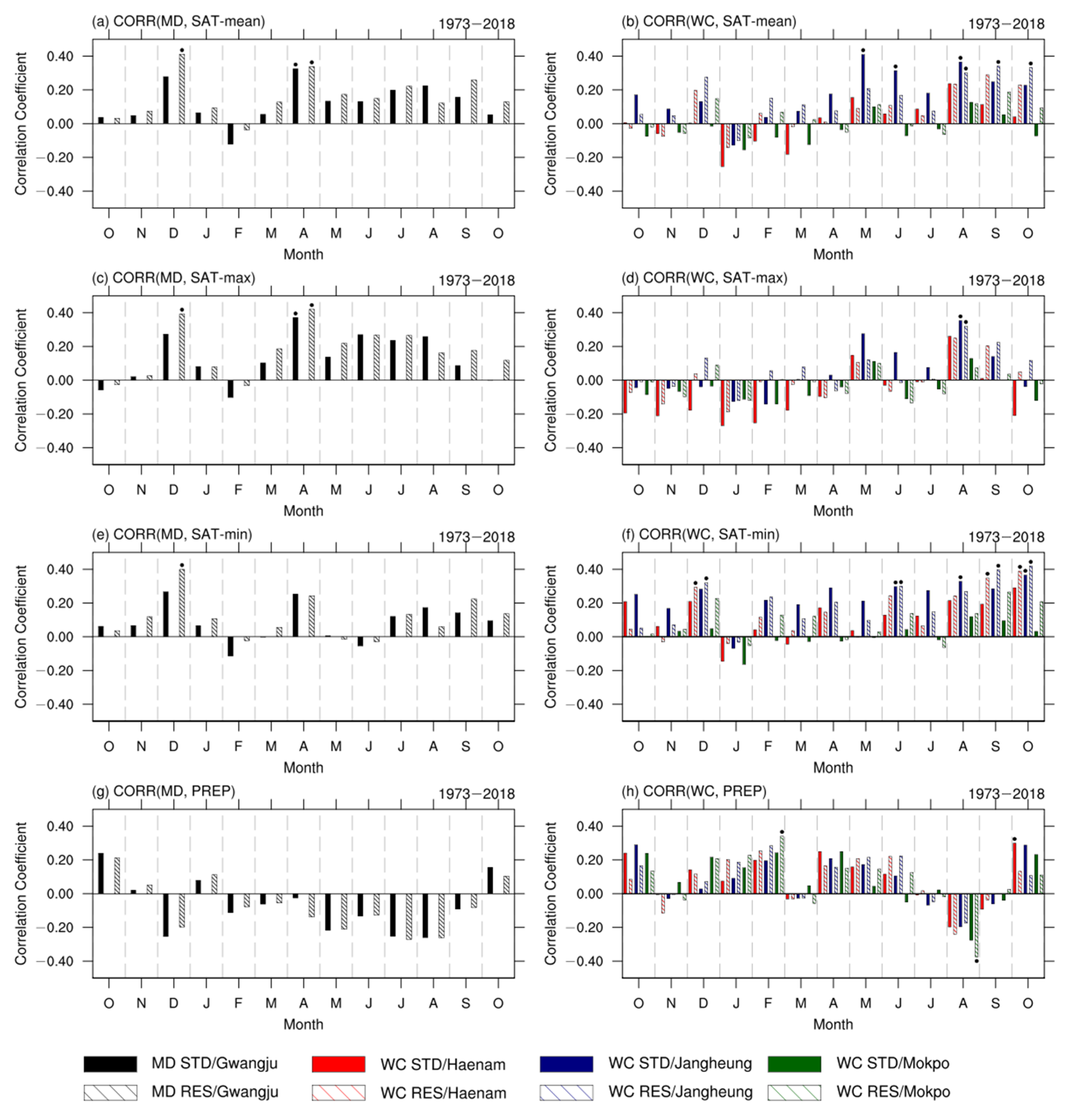
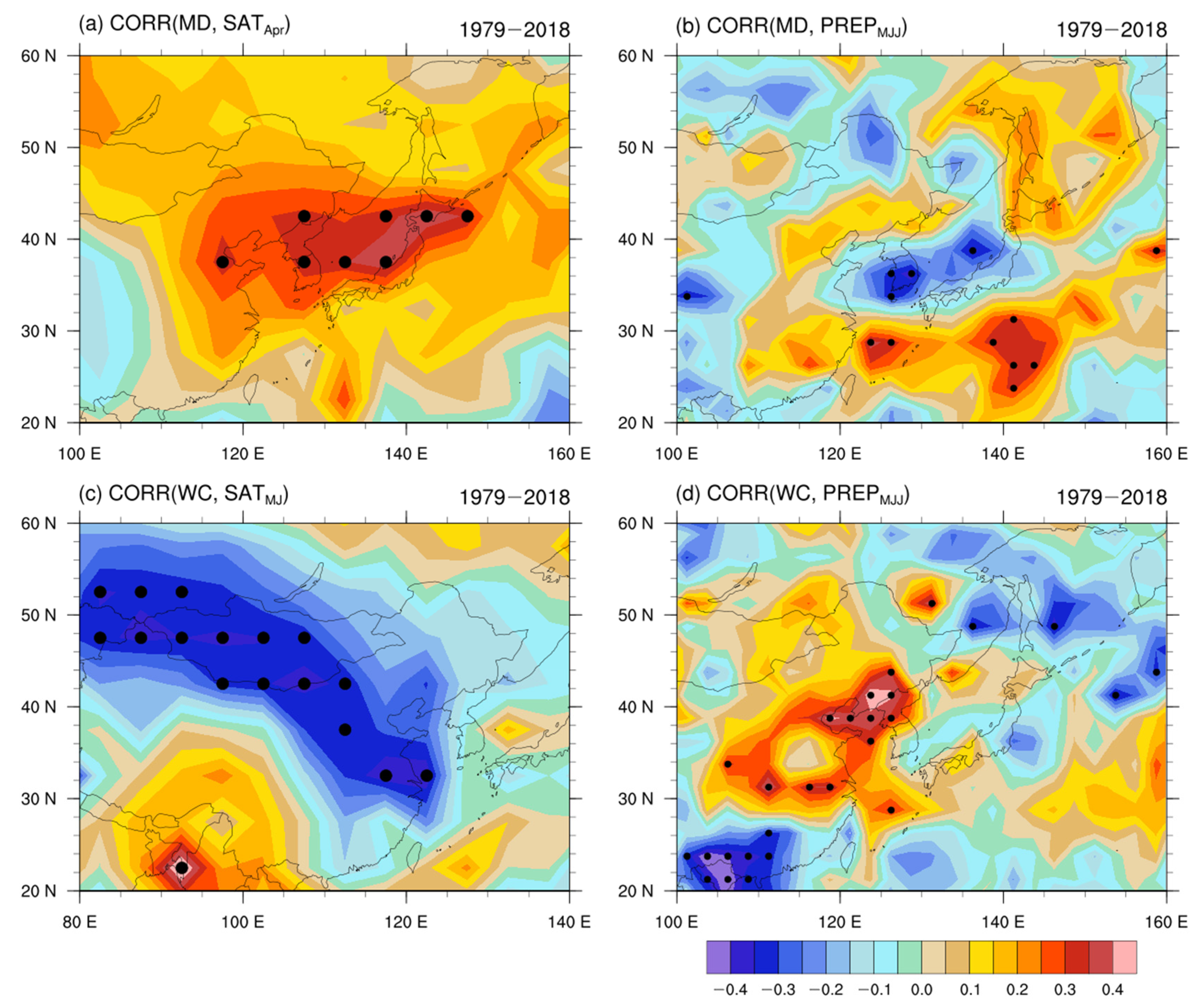
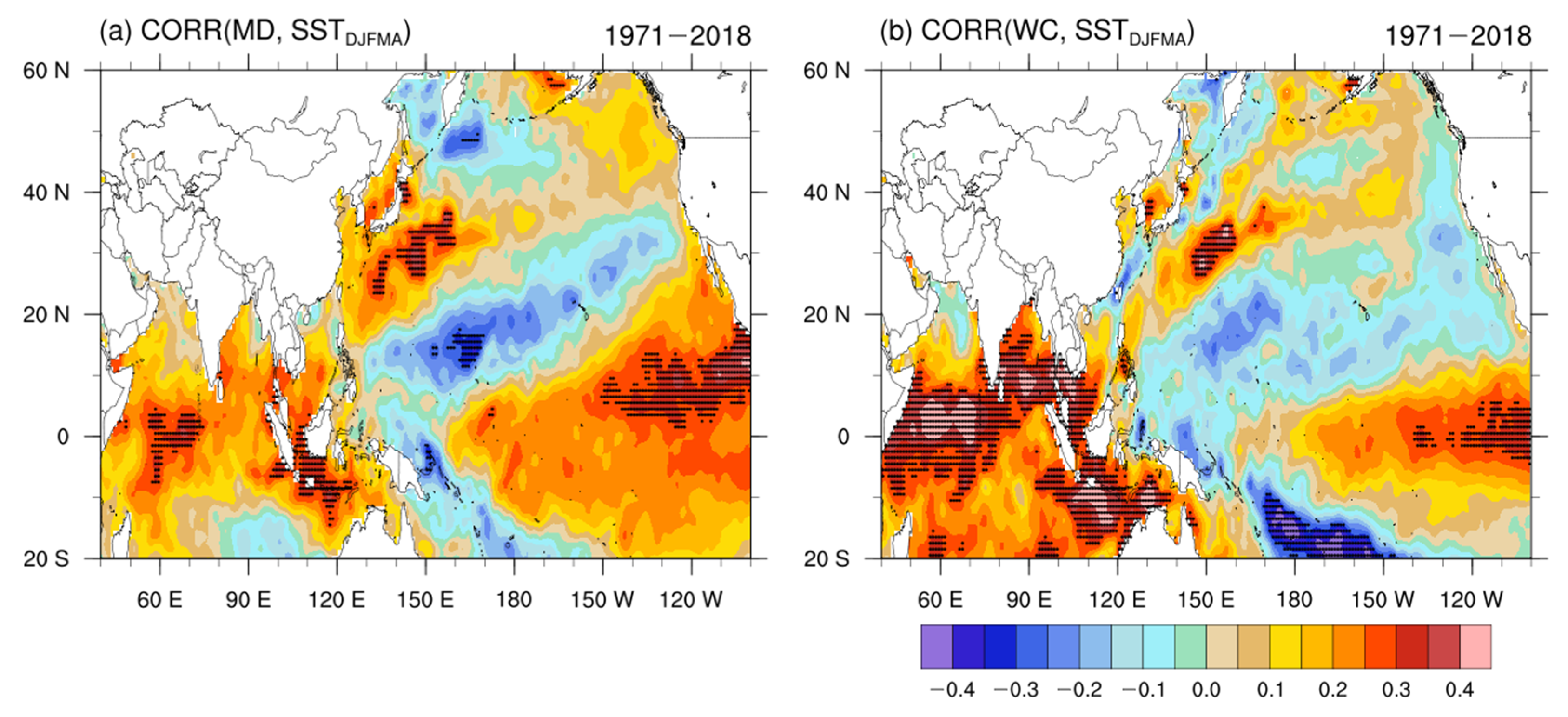
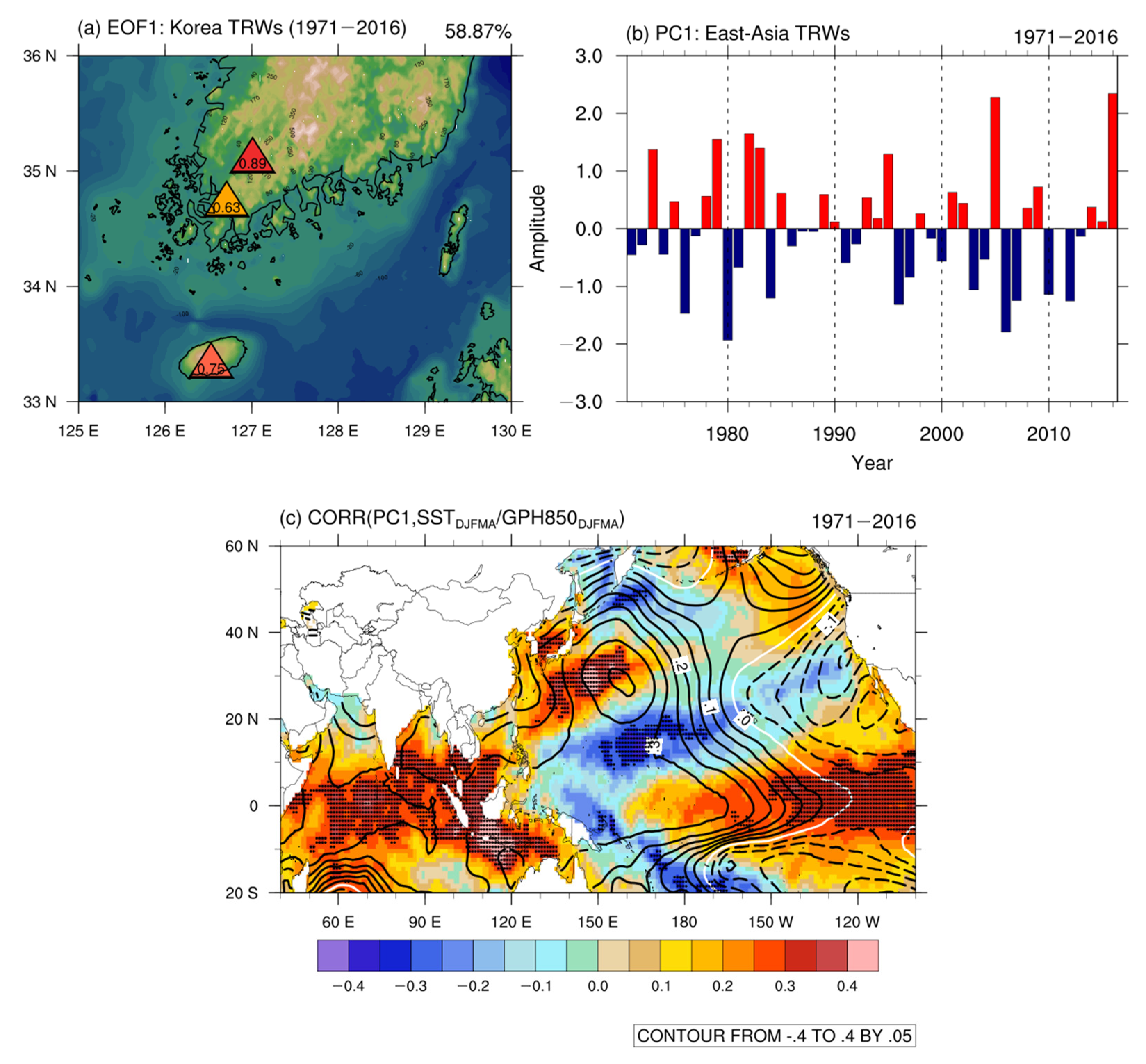
| Code | Number of Cores | Number of Trees | Mean Age | Mean Sensitivity | Interseries Correlation | First-Order Autocorrelation |
|---|---|---|---|---|---|---|
| MD | 151 | 51 | 46 | 0.218 | 0.544 | 0.798 |
| WC | 64 | 27 | 48 | 0.251 | 0.567 | 0.839 |
© 2020 by the authors. Licensee MDPI, Basel, Switzerland. This article is an open access article distributed under the terms and conditions of the Creative Commons Attribution (CC BY) license (http://creativecommons.org/licenses/by/4.0/).
Share and Cite
Kim, M.-S.; Zhang, P.; Woo, S.-H.; Koh, Y.; Linderholm, H.W.; Jeong, J.-H. The Potential of Using Tree-Ring Chronology from the Southern Coast of Korea to Reconstruct the Climate of Subtropical Western North Pacific: A Pilot Study. Atmosphere 2020, 11, 1082. https://doi.org/10.3390/atmos11101082
Kim M-S, Zhang P, Woo S-H, Koh Y, Linderholm HW, Jeong J-H. The Potential of Using Tree-Ring Chronology from the Southern Coast of Korea to Reconstruct the Climate of Subtropical Western North Pacific: A Pilot Study. Atmosphere. 2020; 11(10):1082. https://doi.org/10.3390/atmos11101082
Chicago/Turabian StyleKim, Min-Seok, Peng Zhang, Sung-Ho Woo, Youngdae Koh, Hans W. Linderholm, and Jee-Hoon Jeong. 2020. "The Potential of Using Tree-Ring Chronology from the Southern Coast of Korea to Reconstruct the Climate of Subtropical Western North Pacific: A Pilot Study" Atmosphere 11, no. 10: 1082. https://doi.org/10.3390/atmos11101082
APA StyleKim, M.-S., Zhang, P., Woo, S.-H., Koh, Y., Linderholm, H. W., & Jeong, J.-H. (2020). The Potential of Using Tree-Ring Chronology from the Southern Coast of Korea to Reconstruct the Climate of Subtropical Western North Pacific: A Pilot Study. Atmosphere, 11(10), 1082. https://doi.org/10.3390/atmos11101082





